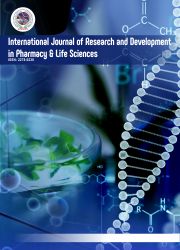Green Chemistry: A study on acid-base indicator property of various flower pigments
DOI:
https://doi.org/10.21276/IJRDPL.2278-0238.2018.7(6).3155-3163Keywords:
Biological Pigments, Green Chemistry, Phenolphthalein, Synthetic Indicators, Acid- base titrationsAbstract
Green Chemistry is considered as a significant tool to mitigate the use of hazardous chemicals. It encourages innovation and promotes the creation of products that are environmentally and economically sustainable. Synthetic chemicals which are used as internal indicators in acid- base titrations being hazardous can be substituted by using the natural indicators which gives results with the same accuracy. The accuracy of the observed results has been examined by performing titration between different acids and bases. Results supported this by less variation in the mean value and titre value from that of synthetic indicators. Thus, the use of natural indicators in the acid base titrations is statistically proved. The natural indicator prepared from flower petals is neither harmful to the environment nor it causes any health hazard. Therefore, in this work the use of natural indicator like petal extract is concluded more economical, simple, harmless, pollution free and inert.
Downloads
References
Georgiev V, Ilieva M, Bley T, Pavlov A, et al. Betalain production in plant in vitro systems. Acta Physiologiae Plantarum. 2008; 30(5):581-593.
Bhagat VC, Patil RD, Channekar PR, Shetty SC, Akarte AS, et al. Herbal indicators as a substituent to synthetic indicators. International Journal of Green Pharmacy. 2008; 2(3):162-163.
Singh S, Bothara SB, Singh S, Pateln R, Ughreja R, et al. Preliminary pharmaceuticals characterization of some flowers as natural indicators. The Pharmaceutical Research. 2011; 5(2): 213-220.
Jaspreet S, Kanika R, Perminder N, Geeta D, et al. Herbal indicators as an upcoming trend in titremetric analysis. International Research Journal of Pharmacy. 2011; 2(4): 177-179.
Abugri DA, Apea OB, Pritchett G, et al. Investigation of a simple and cheap source of a natural indicator for acid-base titration: effects of system conditions on natural indicators. Green and Sustainable Chemistry. 2012; 2(3): 117-122.
Pradeep DJ, Dave K, et al. A novel, inexpensive and less hazardous acid-base indicator. Journal of Laboratory Chemical Education. 2013; 1(2): 34-38.
Vaibhav GN, Vishal BK, Prashant DN, Ganpatrao NM, Suresh TS, Ashish SS, et al. Study of Nerium odoratum as natural, economical and effective alternative to synthetic indicator and litmus paper. International Journal of Pharmaceutical Chemical Science. 2014; 3(2):440.
Grotewold E, et al. The Genetics and Biochemistry of Floral Pigments. Annual Review of Plant Biology. 2006; 57: 761.
Izonfuo WAL, Fekarurhobo GK, Oboman FG, Daworiye LT, et al. Acid-base indicatorproperties of Dyes from local Plants I:Dyes from Basella alba. (Indian spinach) and Hibiscus sabdariffa (Zobo). J. Appl.Sci. Environ. Mgt. 2006; 10(1):5-8.
García-Plazaola JI, Matsubara S, Osmond CB, et al. The lutein epoxide cycle in higher plants: its relationships to other xanthophyll cycles and possible functions. Funct. Plant Biol. 2007; 34: 759-773.
Tanaka Y, Sasaki N, Ohmiya A, et al. Biosynthesis of plant pigments: anthocyanins, betalains and carotenoids. The Plant Journal. 2008; 54(4) 733-749.
Bisht R, Mishra A, Panda B, Praveen K, Panda K, Sahu T, et al. Evaluation of indicator and antioxidant activity of hybrid rose (Rosa hybrida). Journal of Pharmaceutical Research. 2012; 5(1): 428-429.
Pathade KS, Patil SD, Kondawar MS, Naik-Wade NS, Magdum CS, et al. Morus Alba Fruit-Herbal Al- ternative to Synthetic Acid Base Indicators. International Journal of ChemTech Research. 2009; 1(3): 549-551.
Patil SD, Kondawar MS, Naik-Wade NS, Magdum CS, et al. Morus Alba Fruit-Herbal Al- ternative to Synthetic Acid Base Indicators. International Journal of ChemTech Research. 2009; 1(3): 549-551.
Singh S, Bothara SB, Singh SB, Patel R, Ughreja R, et al. Preliminary Pharmaceutical Characterization of Some Flowers as Natural Indicators. The Pharma Research. 2011; 5(2): 213-220.
Ali HFM, EL-Ella FMA, Nasr NF, et al. Screening of chemical analysis, antioxidant, antimicrobial and antitumor activities of essential oil of Oleander (Nerium oleander) flower. Int J Biol Chem. 2010; 4(4):190-202.
Baziar S, Zakerin A, Rowshan V, et al. Antioxidant properties and polyphenolic compounds of Rosa damascene collected from different altitudes. Int J Agro Plant Prod. 2013; 4(11):2937-2942.
Vadivu R, Jayshree N, Kasthuri C, Rubhini K, Rukmankathan G, et al. Pharmacognostical standardization of leaves of Ixora coccinea, linn. J. Pharm. Sci. & Res. 2009; 1 (4), 151-157.
Ratnasooriya WD, Deraniyagala SA, Galhena G, Liyanage SSP, Bathige SDNK, Jayakody JRAC, et al. Anti-inflammatory Activity of the Aqueous Leaf Extract of Ixora coccinea. Pharmaceutical Biology. 2005; 43(2): 147- 152.
Surana AR, Aher AN, Pal SC, Deore1Int UV, et al. Evaluation of anthelmintic activity of Ixora coccinea. J. of Pharm. & Life Sci. 2011; 2(6): 813-814.
Santhi R, Lakshami G, Priyadarshini AM, Anandraj L, et al. Phytochemical screening of Nerium oleander leaves and Momordica charantla leaves. Inter. Res. J. Pharm. 2011; 2(1): 131-135.
Delgado-Vargas F, Jime'nez AR, Paredes-Lo'pez O, et al. Natural pigments: carotenoids, anthocyanins, and betalains - characteristics, biosynthesis, processing and stability. Cri. Rev. Food Sci. Nutr. 2000; 40:173-289.
Wu X, Prior RL, et al. Identification and characterization of anthocyanins by High-Performance Liquid Chromatography-Electrospray Ionization-Tandem Mass Spectrometry in common foods in the United States, vegetables, nuts, and grains. J. Agric. Food Chemistry. 2005; 53:3101-3113.
How to cite this article:
Lavanya D, Guna shekhar G, Purushothom A, Pallavi A. Green Chemistry: A study on acid-base indicator property of various flower pigments. Int. J. Res. Dev. Pharm. L. Sci. 2018; 7(6): 3155-3163. doi: 10.13040/IJRDPL.2278-0238.7(6).3155-3163
This Journal is licensed under a Creative Commons Attribution-NonCommercial-ShareAlike 3.0 Unported License.
Published
How to Cite
Issue
Section

This work is licensed under a Creative Commons Attribution-NoDerivatives 4.0 International License.







 .
.